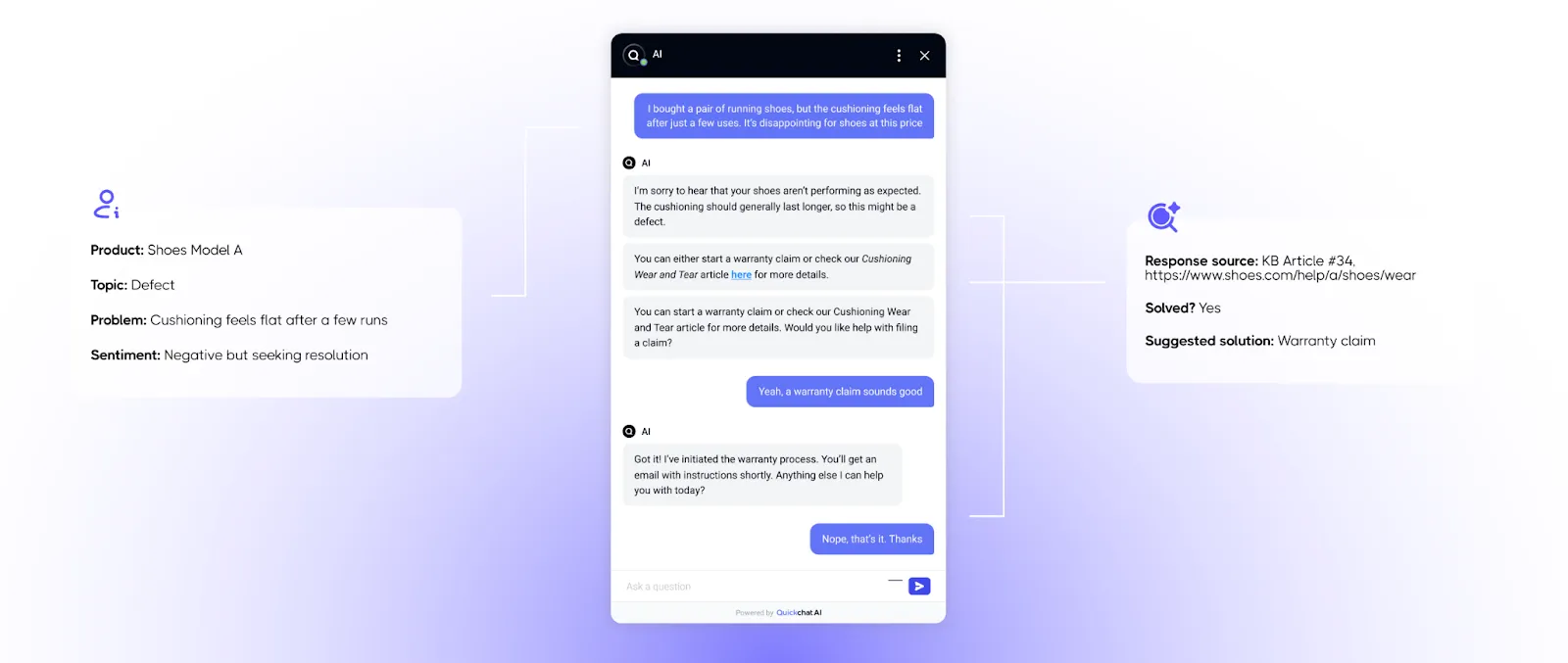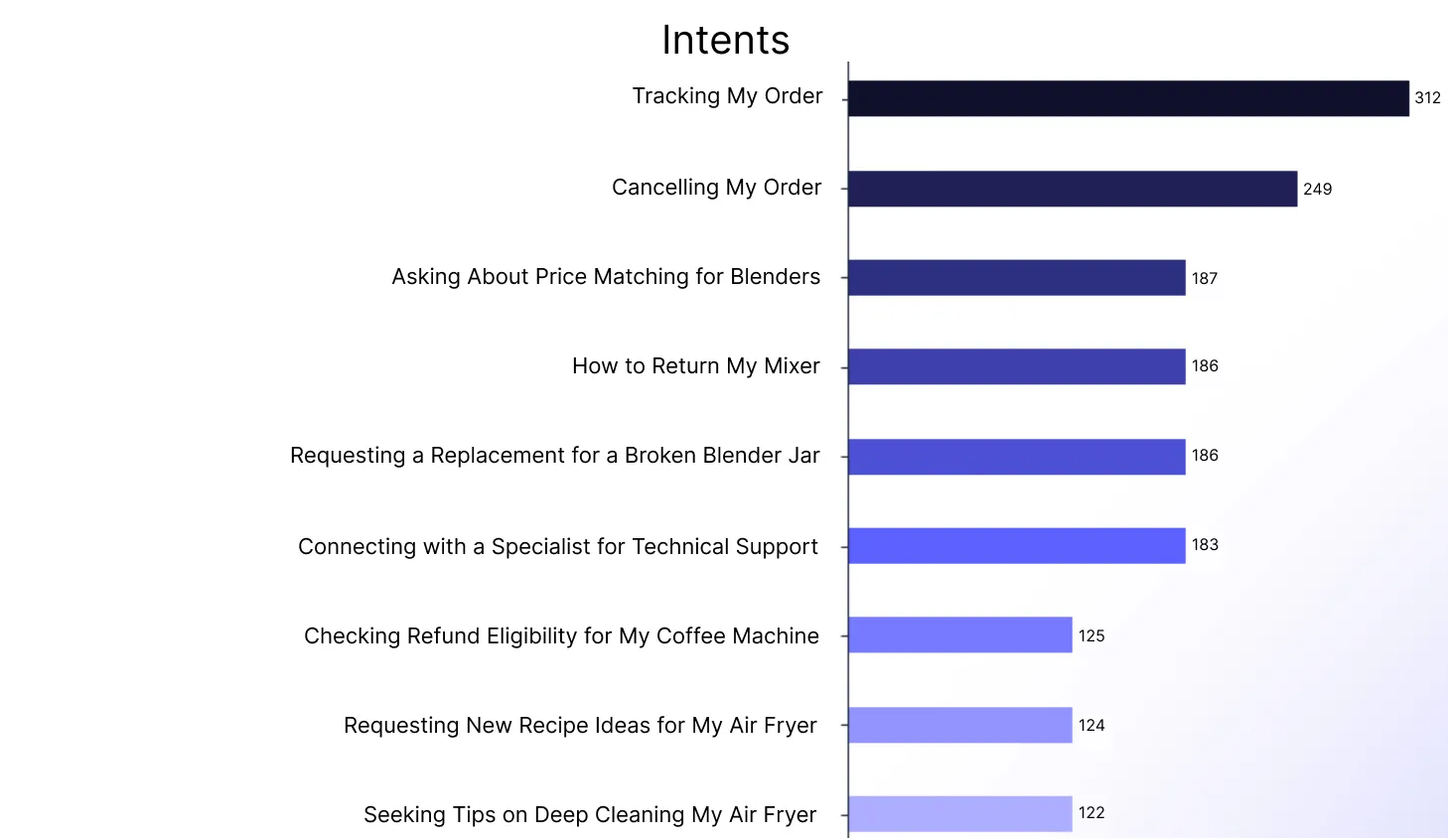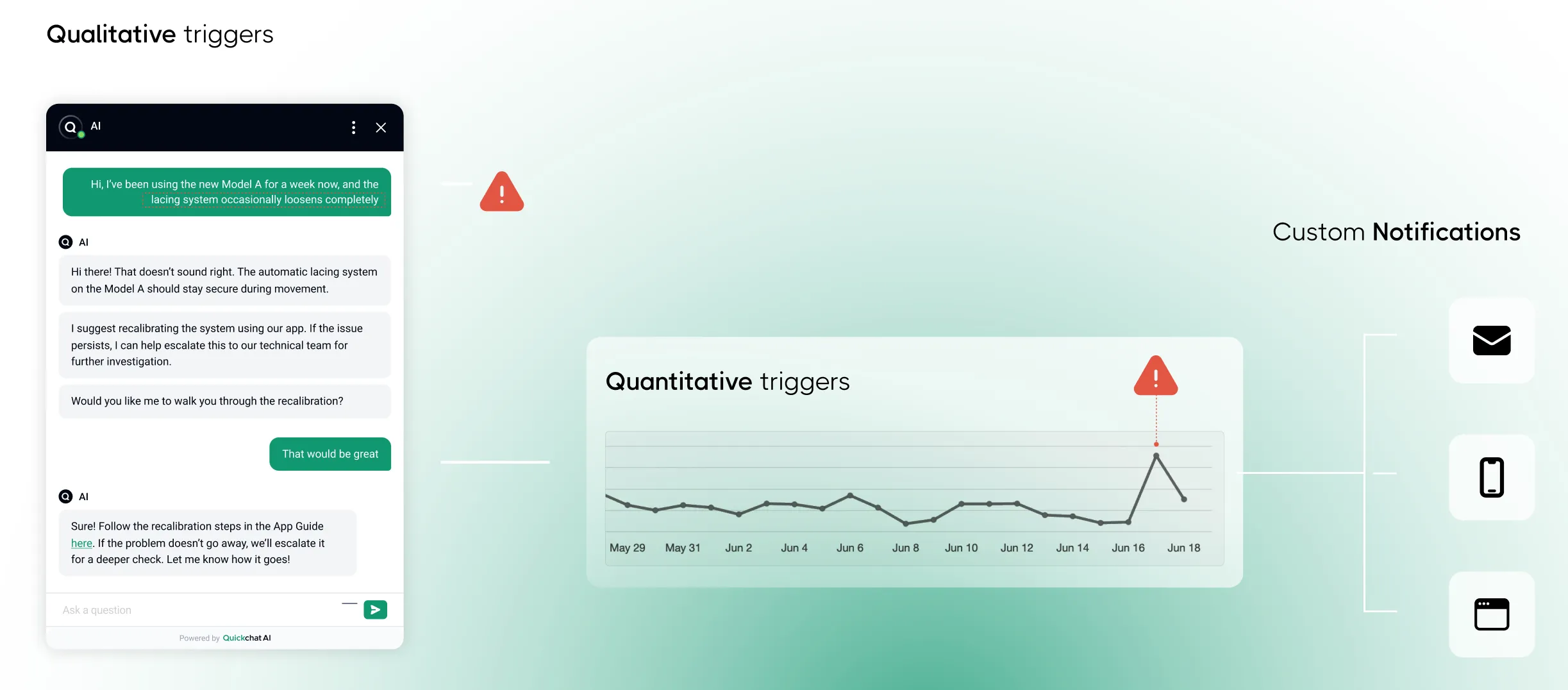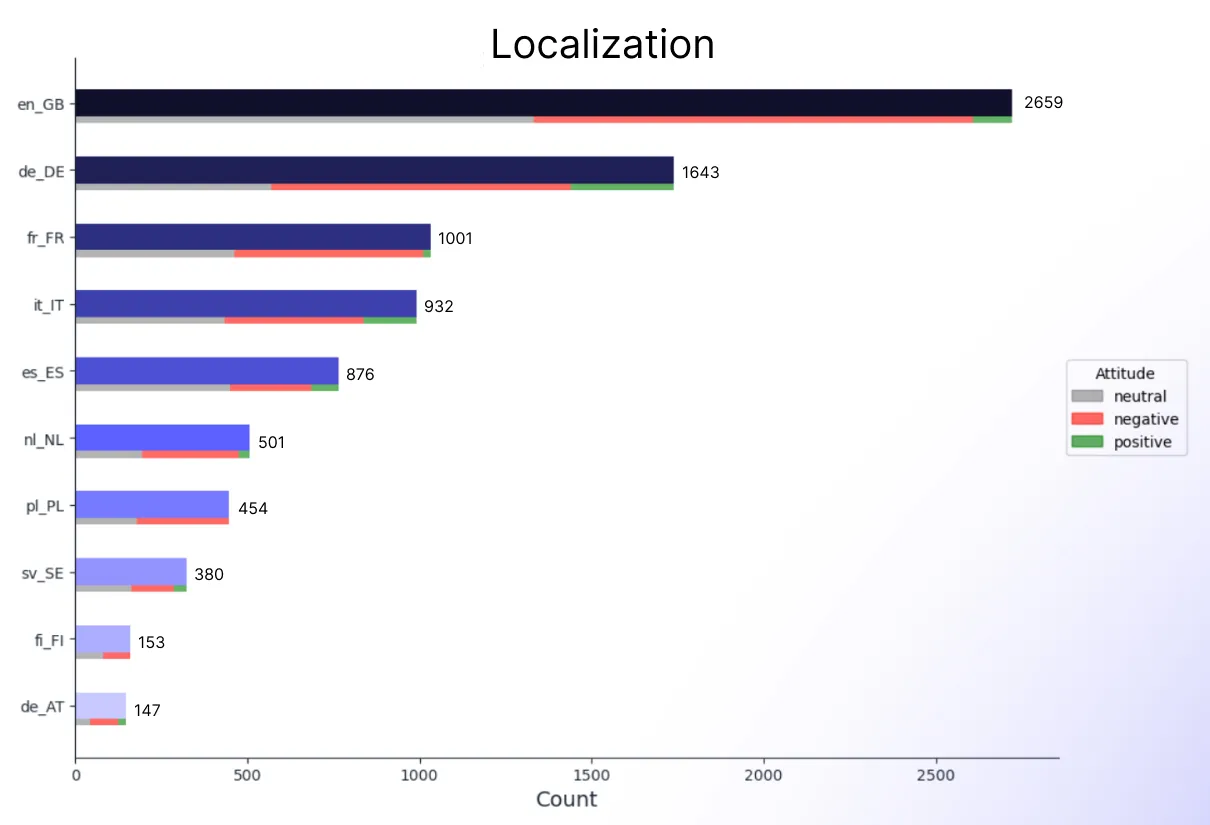Imagine discovering that 15% of your abandoned carts happen because customers can’t find your international shipping rates.
Or learning that customers absolutely love your product’s sustainable packaging — a feature you’ve never even promoted.
These are the kinds of insights that traditionally required conducting customer interviews and surveys. But today, Large Language Models (LLMs) are transforming how businesses understand their customers through automated conversation analytics.
Instead of relying on traditional surveys and surface-level analytics, companies can now automatically analyze millions of customer interactions, reaching a new level of understanding of all our customers.
Uncovering the “Why” behind customer behavior
Traditional digital analytics tell you what customers do — they clicked this button, spent 2 minutes on that page, and abandoned their cart.
But they don’t tell you why.
Consider these limitations:
- A customer spending 25 minutes on your FAQ page might be thoroughly informed — or completely confused
- High cart abandonment rates don’t explain if it’s price, shipping, or a broken “Checkout” button
- Product page bounce rates don’t reveal if customers found better alternatives or simply couldn’t find information about the materials used to make the product
Website analytics leave these crucial questions unanswered.
We need to let customers tell their story — in their own words
In the AI Age, customers can express their needs naturally. Instead of forcing them through rigid feedback forms, they can simply say: “I’m looking for a non-stick pan that works with induction cooktops and won’t scratch easily.” This single sentence reveals:
- Specific product requirements
- Technical compatibility needs
- Durability concerns
- Implicit previous experience with scratched cookware

Like our Insights Module that reveals findings from each customer interaction
Imagine scaling this level of personal understanding.
For example, an online home goods retailer might notice a sudden increase in questions about “flexible storage solutions for small spaces.” Rather than just reacting to this trend, the company could leverage LLM-powered conversation analysis to uncover the underlying motivations — perhaps customers are adapting to remote work setups or downsizing due to economic shifts.
Similarly, an unexpected spike in complaints about a specific product feature could signal a quality control issue that requires immediate attention. Just as some companies use sensor data to proactively address vehicle problems, brands can leverage conversation analytics to spot emerging issues before they turn into a PR crisis.
LLMs can extract emotional insights that traditional reviews often miss
Take for instance a skincare brand launching a new eco-conscious moisturizer. They might find that 70% of conversations express excitement and relief about the sustainable ingredients and cruelty-free commitment. Customers aren’t just satisfied — they’re proud, sharing sentiments like:
“Finally a moisturizer that doesn’t make me feel guilty!”
Meanwhile, a smaller but vocal group raises concerns over product texture and absorption, revealing frustrations:
“I want to love it, but it feels too heavy on my skin,” or,
“The scent is a bit strong — wish it were gentler for sensitive skin.”
Curiosity and hints of skepticism also emerge as some users wonder:
“Does it really hydrate as well as my regular moisturizer?”
“I hope this isn’t just another greenwashed product.”
This level of emotional insight allows the skincare brand to go beyond surface-level sentiment and understand what drives customer loyalty, hesitation, and excitement. In response, they can emphasize the effectiveness of their ingredients, consider developing more skin type options, and ensure transparency.
The journey of LLM-powered conversation analytics doesn’t end with understanding. It culminates in delivering truly personalized experiences.
Just as Spotify uses listening habits to curate playlists, brands can leverage chat histories and other interaction data to provide tailored product recommendations, content, and support.
An electronics store using an LLM to recognize that a customer frequently asks about “gaming laptops with high refresh rates” and prefers “budget-friendly” brands. Based on this, the LLM could suggest specific models, accessories like cooling pads, or even notify the customer when a compatible gaming mouse goes on sale.
But let’s shift from exploring the possibilities to what’s proven.
Some real-life conversation analytics solutions we’ve implemented for our
customers
- Knowledge Gaps
One of the most valuable uses of conversation analytics is in identifying knowledge gaps — when customers ask questions that aren’t covered by existing FAQs, knowledge bases, or documentation. For instance, an LLM might detect that customers frequently ask, “What’s the return policy for items on sale?” even if it’s not explicitly listed on the website. Every unanswered question is an opportunity for improvement. LLMs can detect these knowledge gaps, helping businesses expand their content and ensure that future customers have the information they need at their fingertips.

- User intents
LLMs can classify user intents such as inquiries about product features, complaints, or requests for support. This classification allows businesses to route conversations to the right support channels or automate responses for common queries, enhancing the overall customer experience. For example, an online electronics retailer might use LLMs to detect when users intend to “request a refund,” allowing the system to prioritize these cases.

- Trending topics
With LLMs, businesses can monitor what topics or phrases are frequently appearing in user conversations. Are customers discussing a new feature, a common issue, or a popular product category?
- Anomaly and issue detection
One of the most valuable aspects of conversation analytics is the ability to spot anomalies — unexpected patterns that might indicate a problem. A sudden spike in conversations around product returns or complaints about a specific feature can be detected early.
In the case of a tech product launch, an LLM might detect that users frequently mention “battery overheating” in support chats — a sign of a potentially serious issue. AI-driven anomaly detection enables businesses to catch product defects or emerging issues in real time, allowing them to address the problem before it escalates.

- Sentiment analysis
Sentiment analysis allows businesses to understand the emotional tone of customer interactions. Are users frustrated, satisfied, or confused? You can even break down this analysis in various ways, as shown in the localization chart below.
- Popular product categories and products
LLMs can analyze which products or categories are mentioned most frequently in conversations, shedding light on customer preferences. This insight allows businesses to understand which products generate the most interest. They can identify seasonal trends or shifts in customer preferences to optimize their offerings.
- User language and localization
With LLMs, companies can identify the language preferences and cultural nuances of their users. Understanding the localization needs of different customer segments enables businesses to tailor their messaging and support to resonate with diverse audiences.
LLMs enable businesses to set up custom notifications based on specific conversation patterns, allowing them to stay in the know and respond quickly. If a significant number of customers mention a specific issue, like delayed shipments, the AI can trigger an alert, prompting the support team to investigate.

This real-time capability transforms customer support from a reactive function into a proactive one.
Essentially, your business can be placed in a continuous learning loop where customer interactions constantly feed back into the system, creating a virtuous cycle:
- Customer expresses need or concern
- LLM analyzes and categorizes the interaction
- Insights drive product/service improvements
- Improved offering leads to new customer feedback
- Cycle repeats with richer data
Every user interaction, every message, becomes part of a growing body of insights that improve with time. As LLMs process more conversations, they become better at identifying patterns, predicting issues, and generating recommendations.
They make every customer conversation an opportunity to learn.

